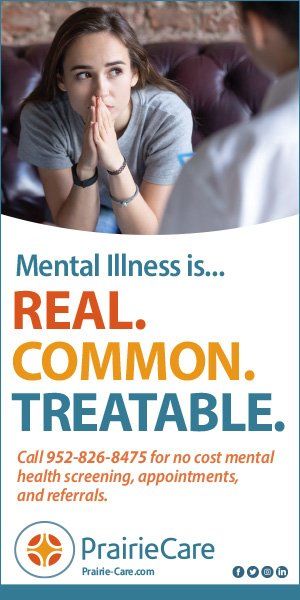very crisis is also an opportunity. And the COVID-19 pandemic is no exception. While COVID has strained the health care system for years now, it also forced providers around the globe to innovate. The disruption of the pandemic, and the isolation it created for millions of Americans, exacerbated the country’s mental health crisis while necessitating new solutions for serving patients in their homes. Thus, the integration of mental health care and home care has catapulted forward.
Behavioral Health
Incorporating Behavioral Health into Home Care
Embracing innovation
BY Stephen Taylor, MA
Since the onset of the pandemic, use of mental health services from home has dramatically increased, and telehealth was permitted for additional services, including adult rehabilitative mental health services (ARMHS). This shift enabled therapists and practitioners across the state to serve thousands of patients who face numerous barriers to accessing in-person care, which was complicated further by the pandemic.
For the future of mental health care, that’s just the tip of the iceberg. The innovation slingshot sparked by COVID has generated new approaches and technologies that will integrate home care with behavioral health care to improve Minnesotans’ quality of life for years to come. But we’ll have to clear several obstacles along the way.
Less than 10% of people experiencing mental health issues receive effective treatment.
Challenges in Mental Health Care
Rates of mental health conditions are rising across the U.S. A 2021 CDC report showed 41% of U.S. adults experienced symptoms of anxiety and depression, up 11% from years prior. However, less than 10% of people experiencing mental health concerns receive effective treatment. A handful of challenges can prevent patients from seeking and receiving appropriate care.
The most significant barrier to mental health care is often cost. CNBC reported that an hourly therapy session can range from $65 to $250, and a person with severe depression spends an average of $10,836 annually on health care costs. Many Minnesotans are hesitant to seek mental health care for fear of how it will affect their pocketbooks.
For the 46 million Americans living in rural areas, geography is also a barrier to healthcare. Treatment centers, hospitals and clinics are more concentrated in urban areas, and in-person mental health services are even less common in rural America. More than 112 million Americans live in areas where mental health providers are scarce.
Additionally, many mental health care professionals are not covered by insurance. Just over half of psychiatrists accept commercial insurance, compared to 90% of other healthcare professionals. Consequentially, individuals seeking mental health treatment are five times more likely to seek out-of-network care, substantially raising the cost.
As a society, we’re working to overcome the stigma surrounding mental health treatment. One study published in Mental Health and Prevention denoted the different stigmas people hold about mental health treatment. The messages of “get over it” and “God is all you need,” as well as the feelings of fear, shame and weakness deter those who need mental health help from seeking it.
With America’s aging population, the mental health crisis will be exacerbated in the decades ahead. Nearly one in five older adults has one or more behavioral health concerns, which can stem from many sources, including the loss of spouses, friends, independence and a sense of purpose. And our aging population presents new challenges to home care providers too.
Challenges in Home Care
By 2038 the number of Americans aged 85 and older is expected to more than double, ballooning from 6 million to 14.6 million. And more so than ever before, older adults want to age in place at home.
But home care comes with its own unique set of hurdles. Home care patients often have complex, individualized needs. About two-thirds of older adults have two or more chronic health conditions. Thus, each patient receiving home care requires a specific, personally tailored plan. This complicates caregiver handoffs and can jeopardize continuity of care without proper communication between caregivers and providers.
Additionally, home care lacks infrastructure. Competitive bidding policies of Medicare and Medicaid services caused a 40% decline in durable medical equipment (DME) companies between 2013 and 2017. This pushed a bias toward low-cost and low-quality equipment, yet patients often need quality equipment and technology to transition from acute care in the hospital back into their homes and communities, especially when dealing with chronic conditions.
As millions of Americans age into their golden years at home, home care and mental health care providers must open the lines of communication and collaborate to best serve the physical and behavioral needs of the individual.
Expanding Access to Mental Health Care
Accra entered the behavioral health space in February 2020 with the acquisition of Lotus Services. Based in Virginia, Minn., Lotus was providing mental health counseling on the Iron Range and was approved to provide ARMHS, helping clients manage the symptoms of mental illness, developing independent living skills and leading more fulfilling lives at home.
The pandemic arrived in the U.S. shortly thereafter, which initially stunted our expansion of mental health services but unveiled the potential of behavioral health care in the home. Later that year, we launched an ARMHS program in St. Louis County.
In March 2022, we acquired Eustice Counseling, a provider of office-based and in-home behavioral health services, also in St. Louis County. The team of mental health providers grew with the acquisition, while adding a new office in Hibbing. Few behavioral health providers exist in northern Minnesota, and just a fraction of those providers offer in-home options.
Home care and mental health care providers must open the lines of communication.
From its origins in Greater Minnesota, the ARMHS program has grown to serve the entire Twin Cities’ seven-county metro area. Counseling is now available via telehealth to clients throughout Minnesota and in-person at a handful of clinics.
For people who live in remote locations or who can no longer easily get around, these in-home mental health counseling options provide increased access, eliminating a common deterrents to seeking care. Patients can schedule appointments via videoconference or phone and even those without technological acumen can access telehealth.
Telehealth also bypasses stigma by providing discreet ways for clients to receive mental health care and avoid scrutiny from others. Making mental health services available in the home will save lives by getting more Minnesotans the help they need.
Connecting Clients with Doctors from Home
To eliminate more silos in the care system, our nurses can now help facilitate telehealth visits between their clients and the client’s doctor. Recently, a client named Peter was having difficulty communicating his health issues to his physician. His prescriptions and follow-up care were often lost or forgotten, forcing his nurse to spend valuable time tracking down orders and medicines. Peter relied on metro mobility and the burden of finding transportation often prevented him from attending onsite clinic visits, even before the COVID-19 pandemic.
Peter’s nurse helped him establish a virtual visit with a new doctor from a Twin Cities health center. She brought a computer to his home, preloaded with forms and client information, and facilitated a video call directly with the doctor.
Since the nurse knew Peter and his medical history, she could help him make the most of the visit with his physician. At the beginning of the visit, the nurse was able to share information about medications and prior health issues that Peter could not readily relay. She also helped him recall critical medical problems and ask pertinent questions while taking notes to address questions about the doctor’s directions after the call.
At the end of the telehealth visit, the doctor prescribed new medication and a follow-up plan. The home care nurse helped Peter keep track of his medications and will assist him with following the doctor’s new orders.
As we continue to develop partnerships with local physicians and clinics, we plan to expand home care services so our nurses can take vital measurements for the physician and even draw blood for follow up labs, effectively bringing the clinic and care into clients’ homes.
Building a Brighter Future
As mental health and home care providers integrate their solutions and expand the applications of telehealth, we must embrace further innovation and burgeoning strategies to re-envision the care process.
Traditionally, mental health care services have been remedial rather than preventative. Most providers typically serve people with long histories of emotional issues or even serious and persistent mental illnesses (SPMI). By the time mental health patients connect with a therapist, their complications are already severe, and they have little to no foundational skills for managing their mental health conditions.
A developmental approach to mental health care will equip future generations with more of the skills necessary to deal with behavioral health issues. This special counseling provides youth with coping skills to manage their symptoms and strategies to get help early on in life. Programs that prevent children from developing SPMIs can help transform our mental health care system from a reactive one into a proactive one, which would profoundly impact society at large.
Foundational change to address the mental health crisis will have impacts on many aspects of life, such as housing. Mental health care services, including the ARMHS program, often connect clients with resources to find and secure available housing. But there is no follow-up once the patients are settled in their new housing.
Providers need to pursue housing stabilization services to help older adults and people with disabilities, including mental illness and substance use disorder, stay in their homes. This assistance with new housing costs, such as rent, security deposits, utility payments and other fees, is designed for the short term. It provides patients with time to develop household management and independent living skills, setting them on a path to a stable life at home.
The traditional practices around mental health prescriptions need an overhaul too. In the past, mental health medication was extremely harsh and only prescribed for severe cases. Today, psychiatric medications are toned down with fewer side effects and risks. And these medications are often needed to complement other forms of mental health care, like talk therapy.
However, home care providers typically cannot prescribe psychiatric medications. Instead, they must refer the client outside of the agency for additional services and assessments, and then eventually prescriptions. This is another barrier we must eliminate to realize an integrated approach to mental health care and home care.
Summary
Various physical, demographic and socio-economic factors continue to form walls between Minnesotans and mental health care services. But providers and innovators have been chipping away at those walls for years, and their work has been hurled forward by the pandemic, bringing us closer to knocking down some of those walls altogether.
Still, the demand for accessible, affordable care will increase as the population ages, especially in rural communities. Reaching Minnesotans across the state with the quality care they need to thrive will necessitate embracing new approaches, applying novel technologies, and, most importantly, integrating solutions bridging home care with mental health care.
Stephen Taylor, MA,
is a licensed psychologist. He is the director and clinical supervisor of the Accra Mental Health and ARMHS Program.
MORE STORIES IN THIS ISSUE
cover story one
Health Care Utilization: Finding the right balance
By Zeke McKinney, MD, MHI, MPH
cover story two
A Missed Opportunity: The Prescription Drug Affordability Board



















